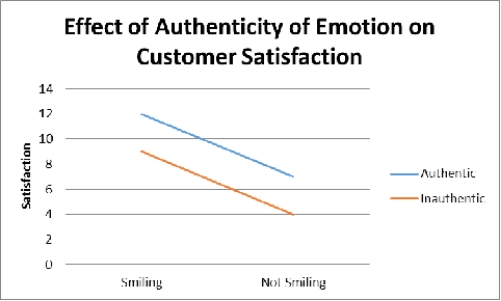Use the following to answer questions
Scenario I
Scenario I is based on fabricated data inspired by the following study:
Hennig-Thurau, T., Groth, M., Paul, M. & Gremler, D. D. (2006) . Are all smiles created equal? How emotional contagion and emotional labor affect service relationships. Journal of Marketing, 70, 58-73.
Do Smiling Employees Improve Customer Satisfaction?
In this 2 × 2 between-subjects design, Hennig-Thurau and colleagues examined the effect of employee emotions and authenticity of the emotion on customer relations. A total of 223 undergraduate volunteers participated in this study. The participants were told they would be testing a new movie consulting service. The movie consulting service was created by the experimenters, and actors were hired to act as customer service representatives. Each participant approached the service desk where the actor asked them a number of questions  Figure 1. Customers rate their experience more favorably when employees are smiling.
Figure 1. Customers rate their experience more favorably when employees are smiling.
-(Scenario I) Suppose each treatment condition described in Scenario I was conducted sequentially with the first treatment tested in the fall semester, and the second in the spring semester. Following testing all treatment conditions the participants received payment for their participation in the form of a gift card. Some received a gift card to a coffee shop and others received one to a megastore. Along with their gift card, participants also received a statement debriefing them of the actual intent of the study. Which of the following presents a potential confound?
Definitions:
Coloring
The act or practice of adding colors to various surfaces or objects, often used as a form of art or creativity enhancement.
Art Projects
Creative endeavors that involve making artistic works, which can vary broadly in medium and scope, often used in educational settings to foster creativity and expression.
Formal Games
Structured games with set rules and objectives, often distinguished from informal or spontaneous play.
Playing Checkers
Engaging in a two-player board game that involves strategic moves to capture the opponent's pieces.
Q15: The abutment teeth of a removable partial
Q40: In an experimental study, random error due
Q46: _ is a special type of within-subjects
Q60: A mixed design has all participants get
Q62: In a factorial design W × Y,
Q82: If a participant scores significantly higher than
Q109: Dr. Timmons is examining reality-based therapy, radical
Q113: The Butler and colleagues (2005) addiction severity
Q114: Dr. Tykr determined that his null hypothesis
Q161: A 2013 empirical exploration of the dynamics